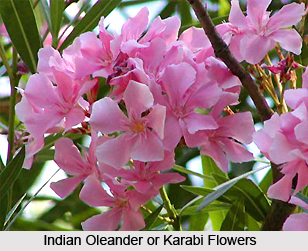 Karabi, Indian oleander, an Indian medicinal plant is botanically named as Nerium odorum Sol. This plant is popular in the name of `Kanera` in Gujarat. In Sanskrit this medicinal plant is called in the name of `Karavira`. In Punjab this plant is known as `Kaneri` and the inhabitants of Tamil Nadu call it `Kanaviram`.
Karabi, Indian oleander, an Indian medicinal plant is botanically named as Nerium odorum Sol. This plant is popular in the name of `Kanera` in Gujarat. In Sanskrit this medicinal plant is called in the name of `Karavira`. In Punjab this plant is known as `Kaneri` and the inhabitants of Tamil Nadu call it `Kanaviram`.
Availability and Cultivation of Karabi
Karabi or Indian oleander is basically found in the wild land in the Himalayas. The plant also springs up in the west side of Nepal to Kashmir and Afghanistan up to about 2000 metre, in the upper Gangetic plain and in Madhya Pradesh. Indian oleander is cultivated in gardens throughout India for the flamboyance of its flowers. The flowers are praised for their gaudy look and are occasionally naturalized in rocky beds of streams and valleys.
Characteristic features of Karabi
Karabi, Indian oleander is a large, erect, evergreen shrub that grows up to the length of 5 meters. The leaves are generally scrolled in three, are devised linear and lanceolate, are acuminate, thickly coriaceous and the surface is shiny with a stout midvein. The flowers of this plant are odiferous, white, pink or red in colour. They are borne in final inflorescence. The fruit is straight and cylindrical. It has a hard surface, without any presence of woolly hair. The fruit remains green at the young stage. It is 15 cm to 23 cm long and contains numerous small seeds tipped with a coma of light brown hairs. In the forests of central India, the flowers generally blossom in November and December and the plant come up with fruits in March and April.
Medicinal properties of Karabi
The roots of Karabi are used for the preparation of the Ayurvedic drug `Karavirah`. Though this drug is well known as a poison but is also used under careful administration, as a powerful cardiac tonic. The properties derived from the root are considered bitter, hot, astringent, anthelmintic, carminative and diaphoretic. It is often prescribed for an external application to the patients suffering from ulcers, leprosy and skin diseases. In Ayurveda, the paste of the root is used externally for the treatment of haemorrhoids, cancers, ulcerations and leprosy. In Unani practice, the juice derived from the root is considered as a good tonic for chronic pain in the abdomen and joints.
The flower of Karabi is also used in Unani medicine for the treatment to inflammations, chronic muscular and joint pain, lumbago, headache and scabies. The Siddha practice incorporates the root bark and flowers of Karabi for curing leprosy, skin diseases, glandular swellings and poisoning. For curing ringworm and other skin diseases a paste of the leaves of Karabi plant and the oil extracted from the root bark is used. A decoction of the leaves is used as an inflammatory agent. The juice derived from the leaves is applied to syphilitic ulcers. The treatment of opthalmia needs the usage of fresh juice of young leaves of Karabi plant.
The roots bark and seeds of Karabi plant contain cardio-active glycosides. The parts of the plant are poisonous and are not for internal consumption.



















